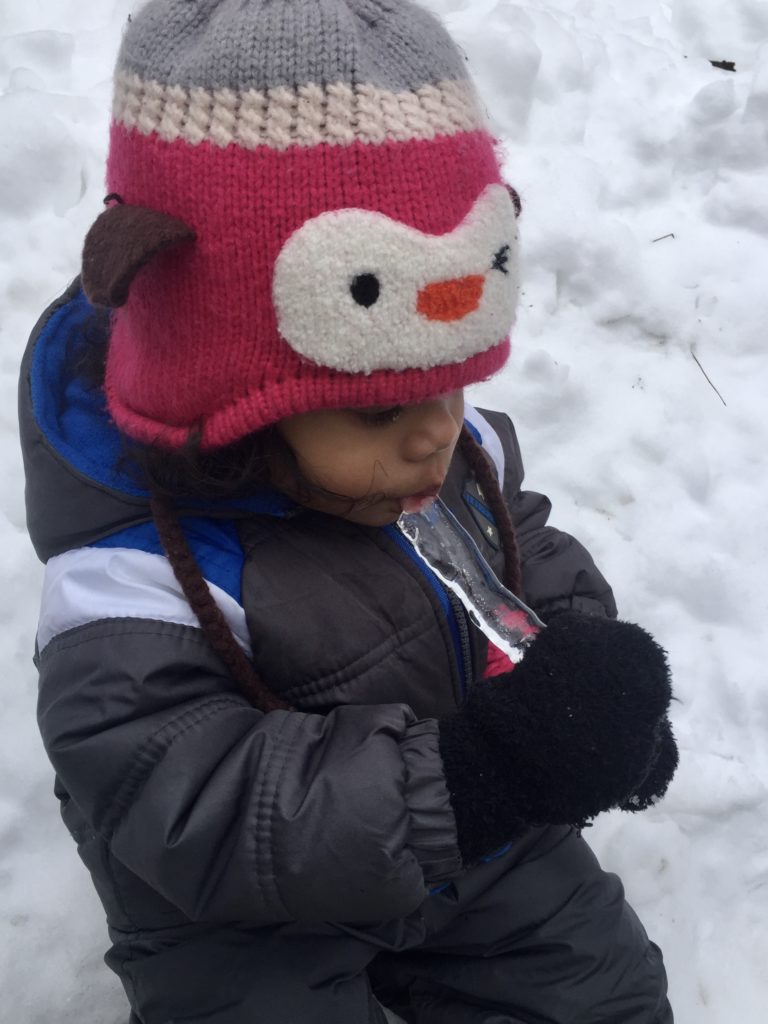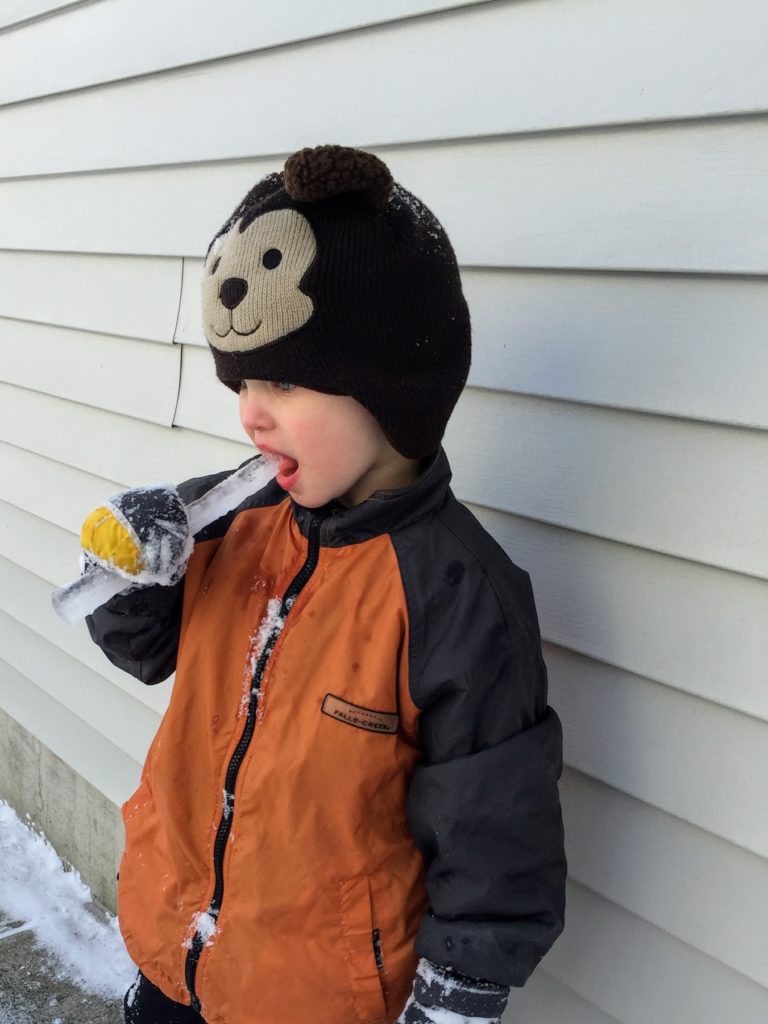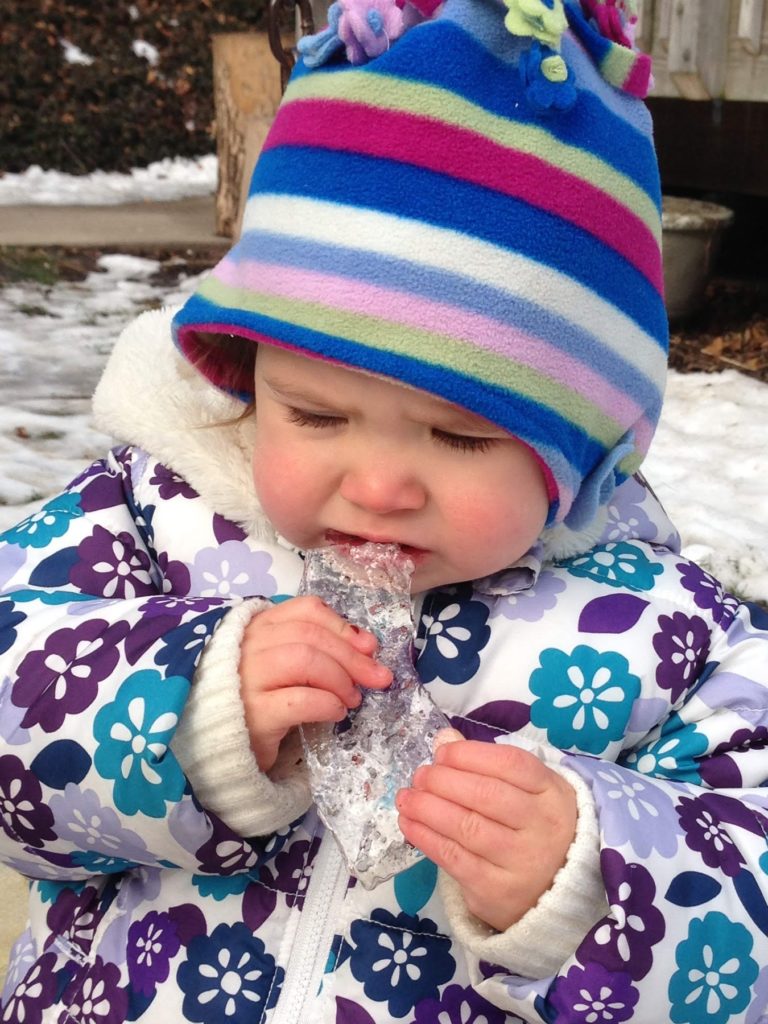Baby, It’s Cold Outside

“LOOK! We have icicles!”
“Can I have one? I need one!”
On this brisk winter morning—much to the children’s delight—nature has given us the gift of icicles. The children’s fascination with these frozen treasures leads to an abundance of “teachable moments” as we engage in some STEM learning while getting some fresh air and exercise.
Soon we are counting, sorting and measuring the icicles. I can practically see those little brain synapses firing as the children use their senses to investigate the properties of the icicles and revel in the joy of being able to choose, hold and taste their STEM lesson for the day.
“My icicle is longer than yours!”
“I like the little icicles! They fit in my mouth better!”
“I like the thick ones, they last a long time! Look how fat mine is!”
When I hear my students discussing size, comparing attributes and sharing their math vocabulary with their friends, my heart just soars. Mathematical language is one of the strongest predictors of children’s early mathematical success. Whenever children discuss relative concepts, they are doing math!

“Aww! I dropped mine and now it is in little pieces!” Janelle wails, holding back tears.
“They still taste good! Now you just have lots of icicles!” says the ever-optimistic Claire. “Before you had one, but now you have more! You have 1, 2, 3, 4, 5! You have five icicles!”
Claire touches each icicle as she counts. The ability to count in sequence and use one-to-one correspondence to determine the number in a set is known as rational counting.
Janelle has the ability to rote count, reciting the sequence in the correct order without an understanding of one-to-one correspondence or the concept of cardinality (the number of elements in a set). “I do have five!” she shouts.
“Look, I can drop mine and it doesn’t break!” yells Owen as he drops the thickest icicle to the sidewalk, only to have a few pieces chip away.
It is difficult to ask children to compare quantities if they don’t know what “more” or “less” means. If they can understand “before” and “after,” they are more likely to know, or be able to understand, what number comes after four. When children learn this language in a math context, they are ready to move on to more advanced mathematical concepts. We are building our math foundation!

“How did you make these icicles? We don’t have them at my house,” asks Rowan as she chomps on her icicle.
“I know!” chirps Robyn. “When the sun warms up the snow on the roof it melts and turns the snow into water and the water starts dripping and then it gets cold again and makes an icicle! “
We take a long look at the ice melting off of the neighborhood roofs and other inclines and see that the dripping has indeed created icicles. We discuss how warm temperatures melt the snow and that is why our clothes often get wet, even when the snow is frozen solid on the ground. Now we have science! I love it when our play leads us right down the path to new STEM experiences and investigations.
“Oh, when our hands are warm in our mittens, it melts the snow? I never knew that!” Logan has processed the information in a way that many of his younger friends don’t have the brain development to do. He seems quite astounded by this realization. Together, we hypothesize which icicles will melt faster or whose icicle will get eaten faster.
Then we swap out our wet mittens for dry ones and hunt for more ice to expand our STEM vocabulary.

Discussions about the weather are often rote and meaningless in early childhood classrooms. Classroom activities that involve calendars and weather patterns can be boring for young children because they are removed from the actual seasons and weather events.
But bringing the children outside to experience the weather firsthand or bringing the snow inside to be investigated on a water table is interesting. Involving the children in hands-on investigations is a much better way to teach concepts such as “winter” or “cold” than directing a child to walk over to a window and report that “It is snowing outside.”
During this busy holiday season, give yourself and your students a chance to escape the heated classroom and venture into the great outdoors to breathe in some fresh air and find your curriculum in the natural world.
I promise you that this approach will lead to far more STEM learning than talking about the weather during circle time!

So much fun to read. It made me think about how much we are teaching during these spontaneous
moments outside in the winter.
I had a lot of fun reading this. I got to learn how much math really impacts kids each day.
I had a lot of fun reading this. I got to learn how much math really impacts kids each day. I love how they used the winter weather to display math to the young children.
I enjoyed reading this experience with icicles. The children had wonderful hands on time, great conversations and explanations about the subject.
I enjoyed reading this. How fun to use math in the winter weather.
This blog makes the connection between math concepts and seemingly everyday/commonplace moments. It demonstrates children’s thinking so clearly, in their own words. They are interested in mathematics in the early years, especially when it is connected to their life experiences. Thank you!
In reading this blog, it has helped me see how math can be easily incorporated in daily weather and simple everyday learning in the classroom. Using what is around the children daily is an easy way to help then in their understanding of early math.
Such cute and engaging conversations amongst the children. I especially loved their conversations about the size and density of the icicles. How many icicles each had – more/less. Sometimes we get so caught up in the ‘teaching’ of concepts during morning meeting or circle time that we miss these naturally occurring ‘teachable moments’ during the children’s play time. So special. Thank you for sharing.
This is so great! I love the fresh new ideas that I can use in my classroom and also measuring icicles who would’ve ever thought! Love it and cant wait until we are able to do some of these activities!
What a great math in nature idea!
I really like this idea. I like that the children were able to participate and engage by talking about how their icicles compared to one another.
with the winter arriving, this will be a fun activity. I could see making patterns with icicles and snowballs, short and long, or even fat and skinny. So much fun to be had outdoors.
How exciting to experience this event. Adding a few tools from inside to explore with would be fun.
A cupcake pan or trays for collecting items to sort, and observe what happens when we go inside will be interesting as we touch what melted on the way in from the cold weather.
I learned just how much math affects kids in everyday activities.
Love seeing how little minds work and how excited they get about things we see every day but for them its entirely new to the. they loved seeing who’s was the longest
Such a fun way to incorporate math in our everyday play.
Such a fun way to incorporate math in our everyday play. The children had great natural math interactions while talking to each other.